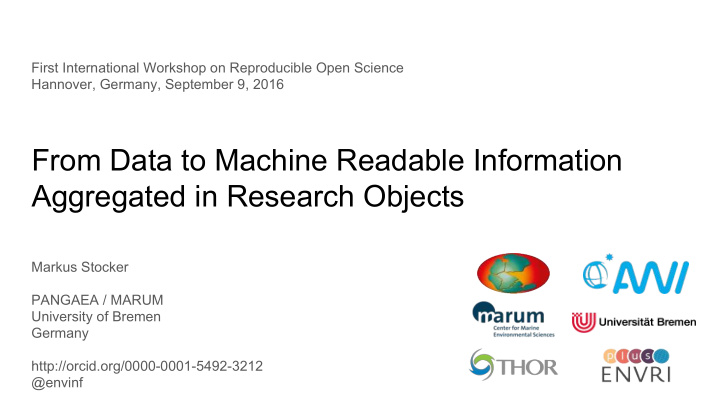



First International Workshop on Reproducible Open Science Hannover, Germany, September 9, 2016 From Data to Machine Readable Information Aggregated in Research Objects Markus Stocker PANGAEA / MARUM University of Bremen Germany http://orcid.org/0000-0001-5492-3212 @envinf
Introduction ● Data interpretation is key in scientific investigations ● Process with data as input and information as output ● Data are uninterpreted symbols, e.g. sensor observation values ● Information are interpreted data, for their meaning in a real-world context ● Record information resulting in data interpretation
Research Object ● “Semantically rich aggregations of resources that bring together data, methods and people in scientific investigations” (Bechhofer et al., 2013) http://www.researchobject.org/
Proposal ● Extend the Research Object model ● Additional Resource type called Interpretation ● Instances represent information resulting from data interpretation ● Instances are machine readable
Proposed Extension
Application
Application
Application
Application <> a ro:ResearchObject ; ore:aggregates ex:d1, ex:f1, ex:d2, ex:s1, ex:e ; dct:created "2016-08-11"^^xsd:dateTime ; dct:creator [ a foaf:Person; foaf:name "Markus Stocker" ] . ex:d1 a wf4ever:Dataset, qb:DataSet ; swrc:doi <https://doi.org/10.6084/m9.figshare.3565635> . ex:f1 a wf4ever:Image ; swrc:doi <https://doi.org/10.6084/m9.figshare.3567273> . ex:d2 a wf4ever:Dataset, qb:DataSet ; swrc:doi <https://doi.org/10.6084/m9.figshare.3571146> . ex:s1 a wf4ever:Software ; swrc:doi <https://doi.org/10.6084/m9.figshare.3571212> . ex:e a ex:NewParticleFormationEvent, ro:Interpretation ; ex:hasClarity ex:strong .
Discussion ● Relevance of ontology because interpretation follows a conceptualization ● Share semantics between humans and machines ● Utilize interpretations to build models, e.g. machine learning classifiers ● Applicable also to Distributed Scholarly Compound Object (DiSCO) ● Link other PID types, e.g. ORCID iD <> a ro:ResearchObject ; dct:creator [ a foaf:Person; dbo:orcidId "0000-0001-5492-3212" ] .
Conclusion ● Data interpretations are artefacts in scientific investigations ● Record interpretations in artefact aggregations, e.g. Research Object ● Record for humans and machines, not just images and natural language text
Recommend
More recommend